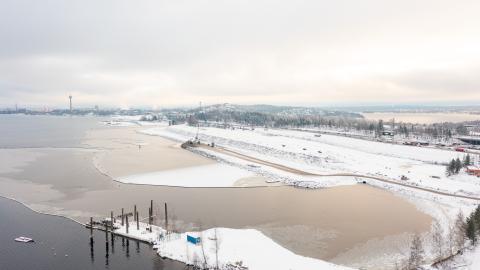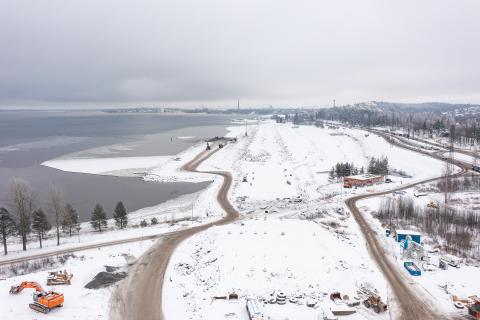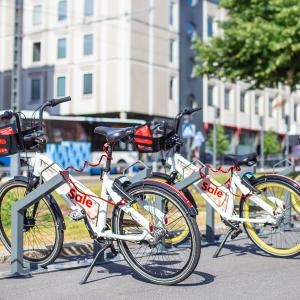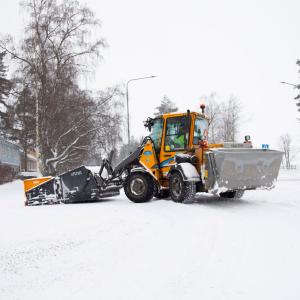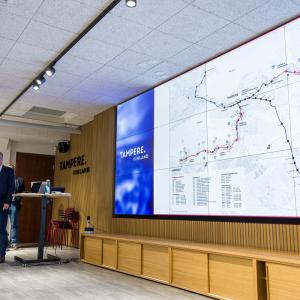The construction project of Näsisaari completed one month in advance
The blasted stone work included in the Näsisaari construction project and the filling of the Näsijärvi water system have been carried out to the planned extent. The work was completed one month early on 30 November 2022. The preloading berms at the future tramway line have also been completed. A total of 1.2 million cubic metres of blasted stone has been driven into the filling and berms, which means 55,000 lorry loads.
Deep sealing work and the construction of erosion protection and slope structures in the periphery of the open side of the waterway filling remain. In other words, machinery is still moving in the area.
The construction of Näsisaari began in February this year. The work will enable the construction of tramways through the future Hiedanranta residential area to Lentävänniemi. As planned, the loading berms will now carry out their work and pre-load the ground underneath the tramway line for one year.
The storm water waterline built for the compilation of waters in the Paasikiventie (National Road 12) area and the associated waterfront walkway have mainly been completed. The waterfront walkway will be finalised later as a new route for walking and cycling to the shore of the canal.
Water quality monitoring has been carried out continuously during the work. During the project, 110 samples of groundwater and 658 surface water samples were taken and analysed. No changes caused by water filling have been observed in groundwater. No new deviations have been found in surface water measurements.
Hiedanranta blasted stone pile no longer exists
The blasted stone that has been stored in a pile in Hiedanranta has now been used for filling. The total amount of blasted stone used for construction is about 1.2 million cubic metres, of which about 1 million were stone that had been in Hiedanranta. Of the stone, 0.2 million cubic metres were imported from other stockpiles.
The contractor responsible for the construction of Näsisaari, Louhintahiekka Oy, managed to complete the stone work that was part of its contract almost one and a half months early, and the preloading berms of trams were completed one month early. The work was completed at the end of November.
The total amount of blasted stone loads on the island is approximately 55,000. Of these, approximately 13,000 loads have been driven via Paasikiventie with semi-trailer equipment and about 42,000 loads along construction site roads with heavy earthmoving vehicles and dumpers.
Some excavation from the stockpiles in Lahdesjärvi will be added to the erosion protection and slope structures to be carried out in the periphery of the open side of Näsisaari island. Turtolan Kaivin Oy is responsible for transporting the stone.
In accordance with the principles of the circular economy, the preloading berm was also made by driving the rock from the loading berm of the Sellupuisto tramway, and as a return load, the moraine that had been in the area of the pile was driven to pre-build the northern block of Hiedanranta.
Only about 10 per cent of the sealing structures in the filling embankment are missing. The drop ball was operated more than 90,000 times for deep sealing.
In connection with the construction of the island, the old water dike at the log floating tunnel and the pier structure in it have also been dismantled.
Protective screens and waters were continuously monitored
The condition of the protective screens in the water has been continuously monitored, and repairs have been made to the screen floats and mountings if necessary. The protective screen has remained intact all the time.
The water quality of the canal between the mainland and island filling has been monitored weekly. The removal of site roads and the removal of the log floating tunnel embankment in the vicinity of the canal caused short-term opacity in the canal. When the opacity was detected, the water exchange in the canal was enhanced by pumping arrangements.
The well-functioning integrated screen kept the opaque water from Paasikiventie between the canal and the mainland. The water in the canal became clearer quickly, and the water in the canal was improved by pumping arrangements.
All waste water discharge pipes from Paasikiventie are connected to the new trunk route, which means that the opacity can no longer spread into the canal. The ramp between Paasikiventie and the waterfront walkway is also fitted with an erosion protection mat to ensure that the ramp does not spread fine material into the canal.
The water quality of the canal between Näsisaari and the mainland is ensured by aeration in the canal, pumping water into the canal and large drum pipes at both ends of the island.
Status of water monitoring
Water samples have been taken from Lake Näsijärvi's surface water on the part of the canal and the vicinity of the screen, and monitoring of oxygen content and opacity has been carried out every week and more often if necessary. For more extensive surface water monitoring that is also located outside the filling area, a two-weekly monitoring programme has been followed.
The situation has been good and the protective screens have kept the opacity inside. The oxygen content in the water in the canal has been good.
In connection with groundwater monitoring, sampling rounds were carried out at the end of September and November. Water samples were taken from all nine groundwater pipes. No changes caused by the island filling have been observed in groundwater quality.
Sediment accumulation is monitored by collectors laid on the bottom of Lake Näsijärvi approximately every three months. The results of water and sediment monitoring were reported to the Pirkanmaa ELY Centre that supervises the project. The monitoring will be continued in accordance with the monitoring programme.
Work completed on Paasikiventie
The storm water line and the waterfront walkway of Paasikiventie have mainly been completed. The storm water line collects storm water from Paasikiventie and leads to Possinoja and then to Näsijärvi according to the general plan for municipal engineering in Hiedanranta.
This very demanding construction work on the steep shoreline of Paasikiventie began in mid-May and was mainly completed at the end of November. The work has been contracted to Ylöjärven Kiviset Oy.
Tramway loading berm collapses are monitored
A loading berm has now been built at the level of +104.00, that is 6.5 meters high, of the tramway on top of the basic level, +97.5 (approximately water level +2 m). For the bridges at both ends of the island, the loading berm is lower. The loading berm is used to load the future tramway foundation. After the loading period, the berm is dismantled to the base level of the tramway foundation layers. The loading berm is dismantled to the edge areas of the lake filling.
During the loading period, the collapses are monitored at the ends of the rods in the wells that are visible in the filling. The total number of these collapse monitoring points is 68, in addition to which the collapse is also monitored from more than thirty observation points installed on the surface of the berm and filling.
At the design stage, the loading period has been estimated at a maximum of one year. When the geology experts of the Tramway Alliance detect that the collapsing has slowed down sufficiently, the berms are dismantled. After that, the tramway and pedestrian and cycling route will be built in Näsisaari as planned.
The protective screen around the island filling is still kept in place.
The construction of Näsisaari bridges will begin in early summer 2023. After the city's contracts, Näsisaari will become the site area of the Tramway Alliance.
Filling the island of Näsisaari in brief
The new Näsisaari island makes it possible to build a tramway to the residential area with 25,000 inhabitants in Hiedanranta and through it all the way to Lentävänniemi.
Length approx. 800 m
Final width approx. 200 m
Channel width 36 m
Amount of blasted stone to be carried
Approx. 1 million cubic metres from Lielahti
Approx. 200,000 cubic metres from Lahdesjärvi
Construction of Näsisaari island (in Finnish)
Learn more about Näsisaari and Hiedanranta (in Finnish)
Learn more about the tramway construction
raitiotieallianssi.fi/in-english/
Further information:
City of Tampere
Developer Petri Leppänen, Urban Environment and Infrastructure Services, Construction tel. +358 (0)50 305 1402
Further information
Petri Leppänen
Construction engineerPhone:
050 305 1402